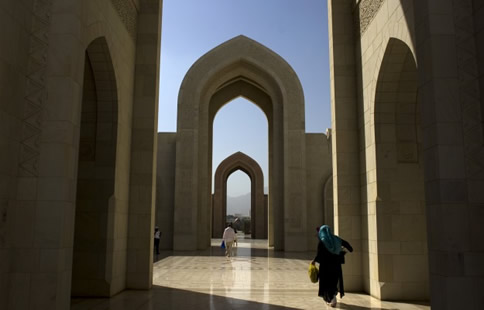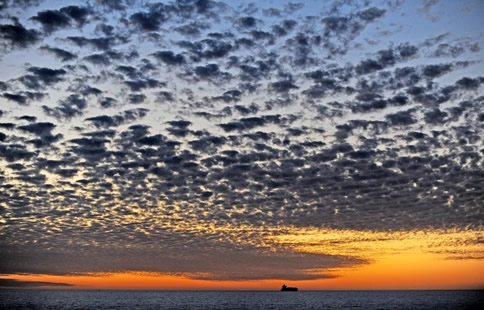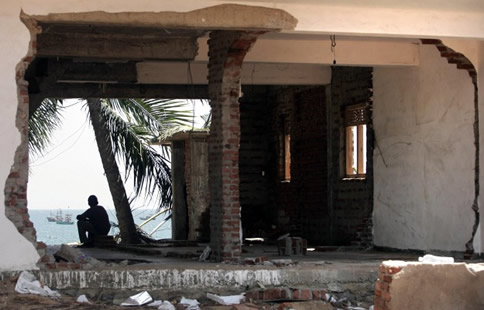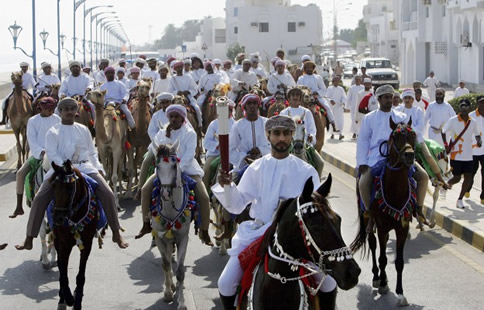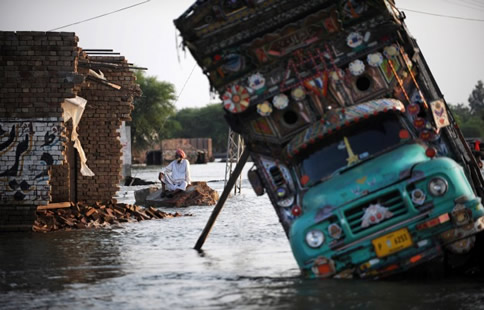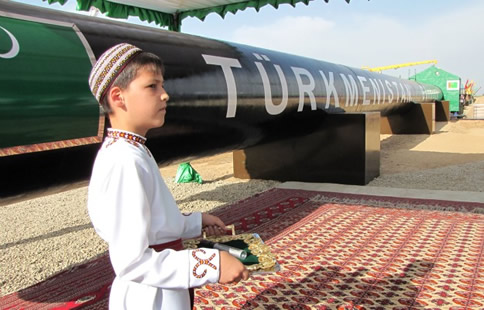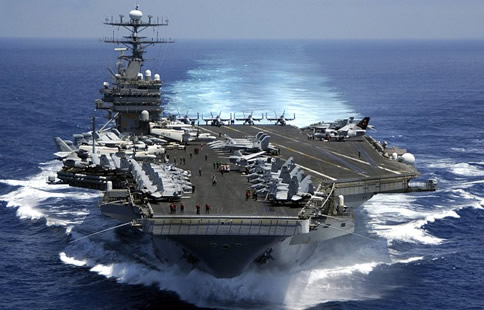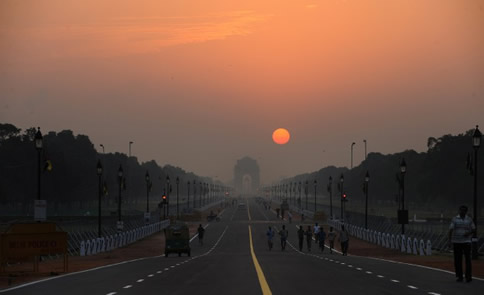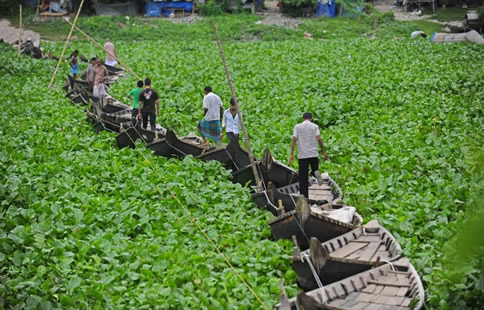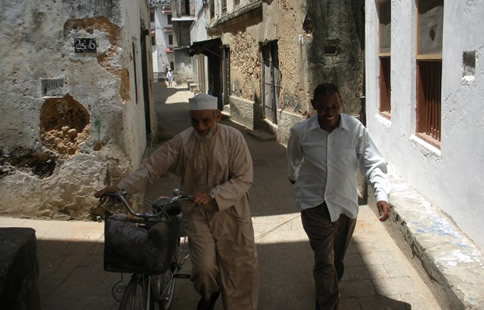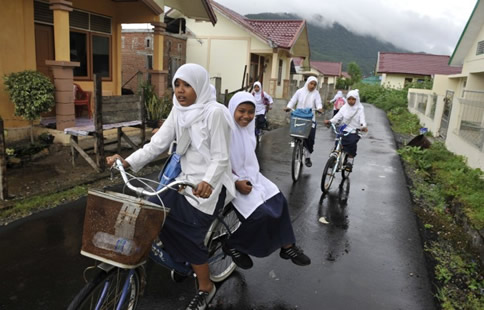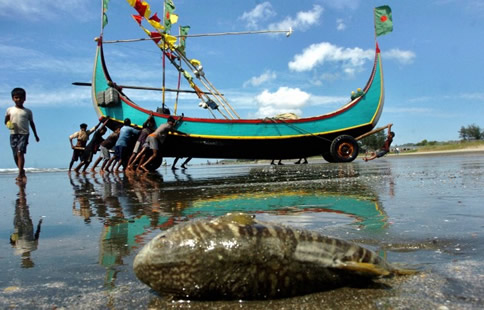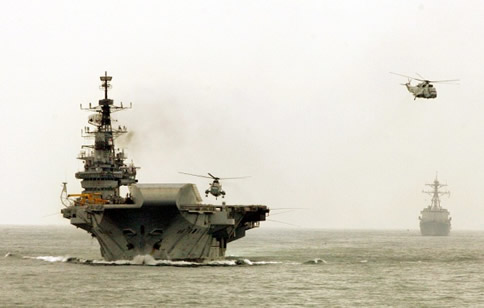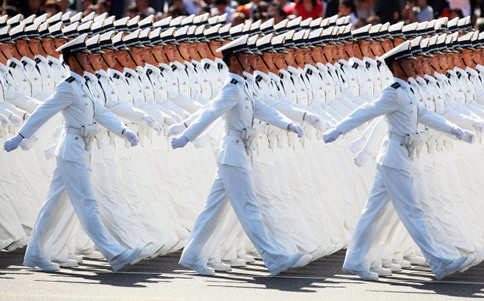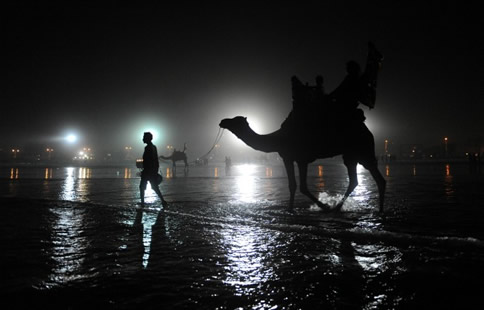Ilankai Tamil Sangam30th Year on the Web Association of Tamils of Sri Lanka in the USA |
|||
 Home Home Archives Archives |
Robert Kaplan's Journey to the New Center of the Universeby Benjamin Pauker, Foreign Policy, October 27, 2010
The Indian Ocean is our future: An exclusive FP photo essay and interview with the author of Monsoon. Visitors walk outside the Grand Mosque in Muscat, Oman, on Feb. 14. Barack Obama has been called America’s "first Pacific president," and his upcoming November Asia trip -- his second since taking office -- backs up this claim. But Robert Kaplan, the noted author of 11 globetrotting books, says Obama needs to expand his focus. It's the Indian Ocean that will soon be the new center of trade, energy, and global politics, he tells Foreign Policy. The new strategic landscape will not be transatlantic or transpacific, but among the countries that make up the "southern Eurasian rim," says Kaplan. "And what unites them all is the challenge of a rising China." Kaplan's new book Monsoon explores the ambitions and rivalries of the countries bordering the Indian Ocean and envisions a slow, but inexorable decline of Western influence. After months of travel to rarely visited corners of world, Kaplan foresees a rivalry between China and India that will consume the region, from Australia to Africa. In an exclusive interview with FP, he talks about how the war in Afghanistan helps China, India's Monroe doctrine, and the perennial struggles between Pakistan's civilian and military governments. David Furst/AFP/Getty Images A container ship sails under a sunset in the Indian Ocean on Sept. 26, 2009. Foreign Policy: Why have you chosen to focus on the Indian Ocean? What is it about this part of the world that's so important today? Robert Kaplan: First of all, we've been prisoners of Cold War area studies for decades. After the end of World War II, the United States found itself a global superpower, and it needed experts for all these regions of the world. So universities and think tanks naturally divided the world up into areas. There was the Middle East, Central Asia, South Asia, Southeast Asia, the Pacific Rim -- what I'm doing in this book is saying that those artificial divisions are in the process of being erased. Instead of the Middle East and South Asia, for instance, there's one organic, flowing continuum around the rim of Eurasia: from the Horn of Africa all the way through the Straits of Malacca and the Indonesia archipelago, and straight up to the Sea of Japan. Second, I wanted to write a book that united the Middle East with the challenge of a rising China and Asia. And the Indian Ocean is a perfect vehicle by which to do that. The Indian Ocean embraces the entire arc of Islam, from the Sahara desert in the west all the way to the Indonesian archipelago in the east. It's the global energy interstate. All of the oil and natural gas that goes from the Arabian Peninsula and the Iranian plateau travels by tankers across the Indian Ocean and up through the Strait of Malacca north to the burgeoning middle-class fleshpots of East Asia. GREG WOOD/AFP/Getty Images The 12,000 ton Singapore cargo shop Winner 12 sits after it ran aground near Kaohsiung Harbor, Taiwan, on Sept. 9. FP: But isn't it somewhat obsolete to be talking about sea lanes and oceans? RK: Despite the jet and information age that we live in, 90 percent of commerce travels by sea -- because it's cheaper. The clothes we wear, our appliances -- they come in container ships from Asia or other parts of the world. The maritime sphere has never been more important than it is now because globalization could not exist without safe sea lines of communication. In fact, one could go even further and say that the U.S. Navy is the ultimate protector of globalization because it dominates the sea lines of communication and keeps them open for merchant shipping. Piracy is an interesting nuisance but not a real strategic threat -- at least not yet. STR/AFP/Getty Images A man looks at a beach from his partly destroyed house in tsunami-hit Hambantota, Sri Lanka, on Jan. 28, 2005. FP: So why have you chosen Monsoon as the title of your book? RK: To an American ear, you hear the word "monsoon" and you think of a storm, you think of the recent catastrophe in Pakistan. But actually, the monsoon is a weather system. It's a wind and weather pattern necessary for agricultural prosperity. When there's a good monsoon in India, the party in power tends to do well because it helps the economy. But here's the key thing: The Indian Ocean is the only ocean in the world that has the monsoonal weather pattern, which means that the winds can be predicted. The monsoon blows in one direction for six months a year and then, like clockwork, reverses direction 180 degrees. So sailing distances can be computed accurately in advance. What that means is that the Indian Ocean did not have to wait for the age of steamships to unite it. It has been a small, intimate ocean -- despite its massive size -- since antiquity. As early as the Romans, sailors were able to cross the ocean with a fair degree of predictability as far as the wind pattern is concerned. TATYANA MAKEYEVA/AFP/Getty Images A horse parade leaves Walis Castle on Day 38 of the 15th Asian Games in Sohar, Oman, on Nov. 14, 2006. FP: So let's talk a little bit about the countries that are on your map. How many are actually democracies? RK: Let's see: Oman is not a democracy, but it has a brilliant benevolent despot, Sultan Qaboos, who I write about in the book. He promotes women's rights, classical music, the environment -- and has a fairly decent human rights record, according to the State Department's yearly report. But as recently as 1970, Oman was extremely unstable. It had war and an insurgency out in the western part of the country. Oman really throws a monkey wrench into Western concepts of good government, because it's an absolute dictatorship and yet it's also a civil society by any standard. Rick Stevens/DAGOC via Getty Images A Pakistani man sits next to a truck surrounded by water in the flood affected village of Visandawali on Aug. 21. FP: What about Pakistan, where governance has been decidedly more topsy-turvy? RK: Pakistan has failed under both democratic governments and under military governments. Throughout the 1990s, they had democratic anarchy. It was so bad that when Musharraf staged a coup in October 1999, it was greeted warmly in Pakistan by all civil-society intellectuals. That's how bad things had become. I write about Pakistan in the context of the two Indian Ocean provinces: Baluchistan and Sindh -- places with really strong regional identities that chafe very much under what they consider ethnic Punjabi domination from the Pakistani political capital of Islamabad and the military capital of Rawalpindi. Pakistan is an extremely troubled democracy; for it to work as a democracy, it has to decentralize. It has to give the provinces, like Baluchistan and Sindh, more political leeway and more tax money. It has to both reform itself as a state and decentralize at the same time. FP: But Baluchistan is a major problem. Its capital Quetta is the home of Mullah Omar, and the CIA is waging an intensifying drone war there. Is there a real desire on the part of the government in Islamabad to actually improve conditions ? RK: Baluchistan also happens to be where most of the mineral wealth of the country is located. And Baluchis claim that the Pakistani government is essentially raping their landscape and bringing all the money back into the Punjab. I write about Gwadar, which is a potential 21st-century seaport (funded by China) that will unite the hydrocarbon and mineral wealth of Central Asia with the sea lines of communication of the Indian Ocean. But when you actually talk to Baluchis in Gwadar, as I did, they're very much worried because they see all the land being grabbed by wealthy Pakistanis who live in Karachi, Lahore, or Islamabad. And they see it as a big land grab where they're going to be cut out of the wealth if this seaport in fact develops. wikipedia.org A Turkmen boy stands in front of the East-West gas pipeline in Shatlyk on May 31. FP: Do the Chinese see Pakistan as a node for importing raw materials? RK: So much of China's energy, its oil and natural gas, crosses the Indian Ocean from the Middle East and is dependent on the navigability of the Strait of Malacca, which is just a few miles wide with a lot of shoals and crowded with ships. And the Chinese would like other ways to get their energy into China. Pipelines through Central Asia: That's one front. STR/AFP/Getty Images The U.S. aircraft carrier USS Carl Vinson sails through the Indian Ocean on March 15, 2009. FP: What role does America's current role in Afghanistan play in China's rise? RK: Basically, if the United States was able to partially stabilize Afghanistan and further stabilize Pakistan, this would be very beneficial to the Chinese. Because the Chinese would then have a road, rail, and pipeline network that would go through much of Central Asia, down to the Indian Ocean. This would include Afghanistan as a nexus for transporting hydrocarbons and also strategic minerals and metals. And if you look at a map of the 8th-century Tang Dynasty, you would see that this is an area that the Chinese have been to before, and though the Chinese didn't occupy it in terms of formal sovereignty, they dominated these trade routes. Now the Chinese are building major port projects, not just in Gwadar in Pakistan but at Chittagong in Bangladesh, in Kyauk Phyu in Burma, at Hambantota in Sri Lanka. Petty Officer 2nd Class Dusty Howell/U.S. Navy via Getty Images The sun rises over the historic India Gate in New Delhi on Oct. 1. FP: You've been talking about China as an actor, but what is India's perspective? RK: The Indians feel surrounded. Now, there's no evidence that the Chinese have plans to put naval bases in any of these places. That would be too provocative to India. But the Chinese will have commercial ports where they'll be able to store merchandise and house their consumer goods for export to the Middle East and Africa. They'll also probably be able to have their naval warships visit. The Indians look out at the Indian Ocean and say, "This is our ocean, not just because of its name, but because we dominate it geographically." The Indians have a sort of Monroe Doctrine outlook on the Indian Ocean. So India has built this spanking new port complex at Karwar, south of Mumbai, to kind of check the Chinese in this regard. You know, there's a movement in India, intellectuals who call themselves neo-Curzonians, which refers to Lord George Curzon, the viceroy from 1899 to 1905. Though he was British, he had a strategic vision of India that a number of Indian policy wonks feel very close to at this moment. Curzon looked out at the world from the same geographical point of view as they do, from India. But Curzon's India once included today's Pakistan, today's Burma, today's Bangladesh, and required shadow zones of influence in the Middle East, Central Asia, and Southeast Asia. India's paying a lot of attention to improving its ties with Iran, the Persian Gulf, and is really competing with China very strongly in Burma. Burma has one of the most repressive military regimes in the world, but that's not stopping the democratic Indians from having bilateral military ties with the Burmese government or providing it with aid. India can't sit by quietly and watch the Chinese make Burma a veritable province. INDRANIL MUKHERJEE/AFP/Getty Images A group of Indian rickshaw-drivers wait for morning tea in Calcutta on Feb. 3, 2009. FP: Do you actually foresee conflict between China and India? RK: I'm not predicting a war. What I am laying out is that the rivalry between India and China will play a big role in defining the geopolitical character of Eurasia in the 21st century. But this rivalry actually has no bad history behind it. India and China really have had very little to do with each other throughout history. They've been two great civilizations that have developed on their own, separated by the impenetrable barrier of the Himalayas. No, this is a rivalry that has a lot to do with the shrinkage of distance caused by the advance of military technology and trade technology. Indian fighter jets, Indian warships, and Chinese fighter jets, Chinese warships -- their zones of influence increasingly overlap. DESHAKALYAN CHOWDHURY/AFP/Getty Images Commuters walk across a floating boat bridge in Dhaka on Sept. 21. FP: What about Bangladesh, does it get squeezed in the middle? Bangladesh is a country that faces enormous environmental consequences -- it's almost a poster child for the problems of climate change, overpopulation, and migration. RK: The Chinese and Indians are playing a very quiet great game of sorts in Bangladesh, Sri Lanka, and Nepal. And what the Chinese and Indians both want is to open trade routes through Bangladesh that would go from southern China through India, through Bangladesh into India down to the Bay of Bengal. Bangladesh is at the head of these potential trade routes, and there are already pipelines that are being built. India and China are competing, and so far it's been for the Bangladeshis' benefit because each has been offering different aid packages and such. But I paint a very, very dismal picture of Bangladeshi government in my book. It's a smaller version of Pakistan: Neither military nor civilian governments have worked. Civilian governments have been corrupt and anarchic and just basically just semicompetent. Military regimes tend to work well their first six months or for a year, but after that become just as bad as civilian governments. That's been the history of Bangladesh. MUNIR UZ ZAMAN/AFP/Getty Images An alleyway in Zanzibar city, Tanzania. FP: What about Africa? It makes up the entire western side of the Indian Ocean and yet all we ever hear about Africa when it concerns the Indian Ocean is piracy. RK: My take on Africa now is that it's revitalizing -- the growth statistics are impressive. And with the economic growth of India, China, and the Persian Gulf, there's money available in all these places for investment in Africa. I believe Africa will be lifted up by the prosperity in other parts of the former Third World and will be swept into this organic trading system. But in this greater Indian Ocean trading system, the Chinese will be the first among equals. Chen Hualin/wikipedia.org Indonesian school children ride their bicycles after school in Lampuuk village, Banda Acech province, on Dec. 3, 2009. FP: What does the future have in store for the region? RK: We're going to see some kind of transition in Oman and it's hard to believe the next sultan is going to be as brilliant as this one, though it has to be said that the present ruler has laid the institutional groundwork for a successful country. Afghanistan and Pakistan are going to remain a great Indian Ocean fault line because of the question of whether they improve enough so that pipelines and roads can be built. And Indonesia is 12 years into what I would call a successful democratic experiment. If you go back to all the dire, dark scenarios for Indonesia around 1998, people thought it would break apart -- they said it was an archipelago that could only be held together by the Dutch or by a dictator. Yet here it is today: the largest Muslim population in the world and a stable democracy that hasn't veered toward radicalism or extremism. ROMEO GACAD/AFP/Getty Images Bangladeshi fishermen push their boat to shore at Teknaf on April 30, 2008. FP: Is there a decreasing U.S. influence in this part of the world? RK: I see that there is. It's gradual; especially if you track it from the end of World War II through the Cold War, the American navy basically dominated the western Pacific and Indian Ocean as American lakes. That's coming to an end because of the growth of the Chinese Navy. And India's going to have the third or fourth largest navy in the world. Thailand is less and less of an American anchor because of its own internal weakness. We've lived in a multi-polar world in economic terms since, say, the mid-1990s or so -- but we're entering a multi-polar world in military and political terms as well. And the Indian Ocean is going to be the place where these political dynamics between India, the United States, China are going to play out. Farjana KHAN GODHULY/AFP/Getty Images Indian aircraft carrier 'INS Viraat' (L) and U.S. destroyer 'USS Higgins' (R) seen during Indo-U.S. naval excercises off the Goa coast, Sept. 29, 2005. FP: What should the U.S. strategy be in this region? Well, the Bush administration promoted India as its kind of favorite country and it's been a substantial success. The rise of India as a great power has been the best piece of luck for U.S. strategists since the end of the Cold War. Because India, in and of itself -- without a need for a strategic U.S. alliance -- naturally balances against China. I think we now need to promote Indonesia as a favorite country, which could also be a natural balancer against China and at the same time help us with the Muslim world. I think the success of democracy in Indonesia is a piece of good news we have paid too little attention to. Indonesia needs us as a kind of hedge against China but cannot say that too loudly for fear of alienating the rest of the Muslim world. But Indonesians will say that quietly to us behind closed doors. SEBASTIAN D'SOUZA/AFP/Getty Images Chinese People's Liberation Army Navy (PLAN) sailors march pass Tiananmen Square during the 60th anniversary celebrations of the founding of the People's Republic of China on Oct. 1, 2009. FP: So you'd agree that the Obama administration has made a wise choice in seeming to focus on Asia rather than Europe? RK: A major global trend is that military strength is migrating from Europe to Asia. While European defense budgets get cut, they're rising in Asia. Asia's becoming the center of the world, as it has been economically for decades. And this is normal: decades of strong economic growth lead to sophisticated militaries. So Obama is just facing reality here. I would go so far as to say that what the United States needs to do is try to shift our attention to the degree that we can from Iraq and Afghanistan to East Asia. If our top policy makers are constantly preoccupied with a war in Afghanistan, or getting out of Iraq, that's less attention to East Asia and the southern Eurasian rim. Feng Li/Getty Images People ride camels on a beach at midnight in Karachi on May 5, 2009. FP: To what extent are the forces of nationalism going to assert themselves against the networks of globalization? RK: I think in the area we've been talking about, nationalism is going to be very strong. It's not going to be like Europe, which is in this Kantian, post-nationalism, era of perpetual peace. East Asia and South Asia are different. Nationalism is relatively young. It's very virile. These countries have stronger and stronger militaries and are not apologizing for them. They take pride in their atomic weaponry. The Pakistanis, the Indians -- the fact that they have the bomb -- is a signal of pride for the rising middle classes in these countries. So I think what we're entering is a kind of very complex balance-of-power world here. This makes for more complicated world. The United States is going to have to work harder and harder to retain the same level of influence. We have competitors now to a degree that we haven't had in years
|
||
|
|||
